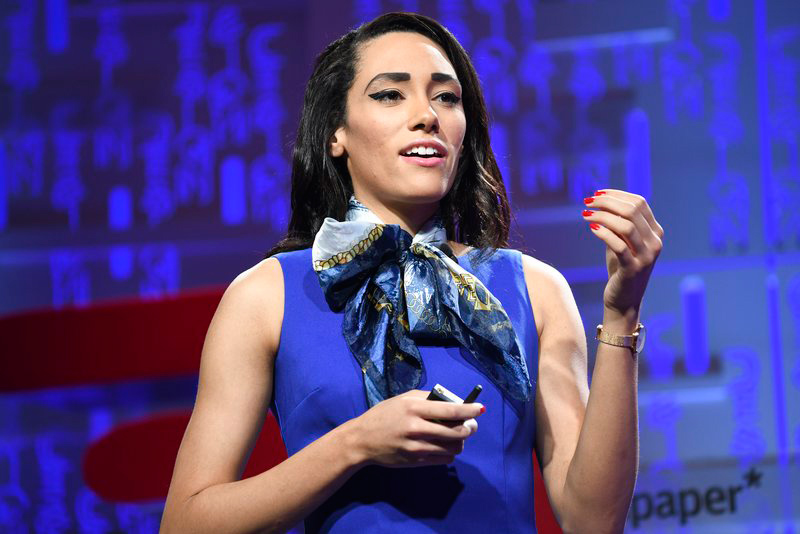新兴技术太强大,让人担忧

|
深入研究就会发现,设计师的目标是解决问题,而从定义就能看出,技术就是一系列解决问题的工具。 为什么要一边恐惧一边欢迎新兴技术呢? 不久前在新加坡召开的《财富》头脑风暴设计大会上,设计师们讨论了这个悖论。 “想象一下使用这些媒介后世界会是什么样子,很不可思议。” 斯坦福大学设计学院的执行董事莎拉·斯坦·格林伯格表示。她推动了一场讨论,嘉宾包括Impossible Foods的高级香料科学家劳拉·克里曼、Vantage Point的创始人及首席执行官摩根·默瑟和斯坦福大学设计学院高管培训项目学习经验设计的负责人凯瑟琳·塞戈维亚。 专家们一致认为,虚拟现实、人工智能与合成生物学等技术一方面让人困惑,另一方面也能激发灵感。 各种新技术让很多人困惑,因为很少有人真正了解如何使用。“技术越来越容易使用,但精通各种技术的多元化设计师群体并未形成。”格林伯格表示。 不过,积极运用新兴技术的设计师们表示,可以帮忙解决曾经看似无法克服的问题和挑战。 比如拯救地球环境的种种努力。克里曼指出,气候变化和生态破坏的重要因素之一是人类热爱肉食。肉类生产是资源密集型产业,消耗了地球上30%的淡水,导致了全球15%的温室气体排放。 “人们喜欢吃肉,强制移风易俗行不通。”克里曼说,他的公司位于加州,主要生产肉类和乳制品的植物替代品。 克里曼说,她和团队进行了深入研究,找出肉类口感的“秘密来源”,发现是一种叫血红素的化合物。她们公司利用合成生物学手段从植物中提取血红素后大规模生产,开发肉类替代品,她表示替代品几乎可以满足所有人的味蕾。 “我们没有重新设计最终的产品,只是重新设计了制造产品的工艺。”她说。“产品是由植物直接制成的肉,可以说省略了‘中间有牛参与的部分’。” 从米其林星级餐厅到快餐连锁店,全世界6000多家餐馆都在供应植物肉制品。不久前,新加坡的7家餐厅也开始供应。 按照默瑟的说法,虚拟现实可以让人类更聪明。她在洛杉矶的设计咨询公司就在研究该项技术。她说,研究表明虚拟现实训练能提升75%的知识留存率。可以通过多种方式利用该项优势。 想象准备演讲的场景。演讲者要练习排练,还要记住表现最好的细节。听起来挺顺利,但等到真正发表演讲面对真正的观众时,还是会紧张。通过虚拟现实,演讲者可以在真实观众面前排练。真正演讲时便轻车熟路。 “身临其境的媒介非常真实,非常有力,也非常有影响力。”默瑟表示。 怎么看算法?斯坦福大学的塞戈维亚说,近年来批评声音不少,但算法只是工具,不管产生的结果有用还是令人恐惧,最后都要看创建算法的设计师。 谈到新兴技术时,设计者们都同意造出好产品的可能性很大。格林伯格补充说,为了真正实现,设计师应该考虑想要生活的世界什么样,以及不愿生活的世界什么样。(财富中文网) 译者:冯丰 审校:夏林 |
When you get down to it, designers aim to solve problems, and technology is, by definition, a series of tools to do just that. So why we do we fear and embrace emerging tech with equal measure? Designers convened at Fortune’s Brainstorm Design conference in Singapore recently to discuss the paradox. “It’s amazing to think what the world might look like when you apply these mediums,’’ said Sarah Stein Greenberg, executive director of the Stanford University d.school, who facilitated a discussion that included Laura Kliman, senior flavor scientist at Impossible Foods; Morgan Mercer, founder and CEO of Vantage Point; and Kathryn Segovia, head of learning experience design in the executive education program at Stanford’s d.school. Technologies like virtual reality, artificial intelligence, and synthetic biology can both confound and inspire, the panelists agreed. These technologies confound many of us because few of us truly understand or know who to use them. “They are becoming more accessible, but there is not yet a diverse community of designers” fluent in these technologies, Greenberg said. But the designers who employ emerging technologies today have begun to show us that they can help solve problems and challenges that once seemed insurmountable. Consider the effort to save the planet’s environment. One of the most significant contributors to climate change and ecological destruction is our appetite for meat, Kliman noted. Meat production is enormously resource intensive, using 30% of all the fresh water available on the planet and producing 15% of global greenhouse gas emissions. “People love meat. Asking them to change their behavior isn’t going work,’’ said Kliman, whose California employer makes plant-based substitutes for meat and dairy products. Kliman said she and her team conducted deep research to identify the “secret source” of what gives meat its flavor, and found it is a compound named Heme. Using synthetic biology, her company extracted Heme from plant sources, produced it at scale and developed meat substitutes that she said can satisfy just about anyone’s taste buds. “We are not redesigning the final product. We are redesigning the process to make that product,” she said. “It is meat made directly from plants. I like say we cut out the ‘middle cow.’” Her plant-based meats are now being served in over 6,000 restaurants worldwide from Michelin-starred bistros to fast food chains. And on Wednesday, seven restaurants in Singapore began serving them, too. And then there’s virtual reality—which can make all of us smarter, according to Mercer. Her Los Angeles design consultancy works with the technology. Studies show that virtual reality training can increase retention of knowledge by 75%, she said. That benefit can be applied in a number of ways. Imagine someone preparing to give a speech. They practice, rehearse, and memorize the best parts. It all sounds smooth until they actually deliver the speech and become nervous in front of a real audience. With virtual reality, a speaker can rehearse in front of what looks and feels like a real audience. Delivering the real speech then becomes a piece of cake. “Immersive mediums are so real, so impactful, so influential,’’ Mercer said. And what about algorithms? They’ve gotten a bad rap in recent years, said Stanford’s Segovia. But they’re just tools—whether they produce results that are useful or terrifying depends on the designer who creates them. When it comes to emerging technologies, the possibilities for producing good are great, the designers agreed. To achieve that, Greenberg added, designers must think about the world they want to live in, and the one they don’t. |











